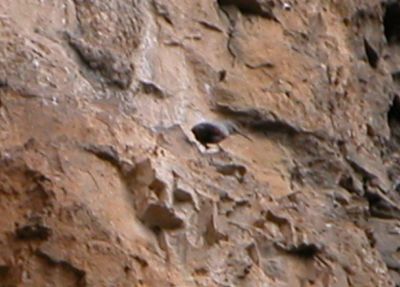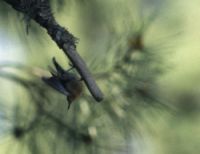Corsica - July 1991
Introduction
Though in July Corsica is
certainly too hot, too dry and too crowded, it is still worth the extra effort.
If you have a choice : may-june must be lovely.
I was accompanied by my wife and two children, who enjoyed some highlights of
birdwatching as much as I did. We reached Corsica (Bastia) by ferry on the 2nd
of july and left it by the same means on the 3rd of august. Between those dates
6 camp sites were visited and close to a 100 species were seen/heard, including
4 new ones to me : Cory's Shearwater, Alpine Accentor, Marmoras Warbler and
Corsican Nuthatch .
Having read some reports by other birdwatchers I will try to give extra
information about the distribution of some species, worth visiting Corsica for.
But you should remember: it is july, which means little singing activity of the
birds.
Practical remarks
- Ferryboats leaving from
Italy (e.g.Genova, La Spezia) are much cheaper than the SNCM-boats from France.
- Corsican soil is tough and rocky, which you should bear in mind when you plan
to camp there with a tent.
- I can recommend : "Parc Naturel Regional de la Corse - les oiseaux"
price FF 50, available in most bookshops in Corsica
A good map of Corsica you will find at:
The following sites contain
lots of information on this isle:
http://www.corsica.net/corsica/uk/venir/venir.htm
http://www.visit-corsica.com/
http://www.internetcom.fr/corsica/index.htm
http://www.parc-naturel-corse.com/
http://www.surfbirds.com
Species
Cory's Shearwater
"en route" to and from the isle
Lammergeier
at two places in the upper part of the Ascovalley on the 12th of july; other
possibilities are "le Col de Verghio" and the Valley of Asinao.
Osprey
improving numbers on the mid-western shore, a.o. one pair of these birds on
"Capo Rosso" (west of Piana) on 28-7. Main breeding area seems to be
La Scandola.
Audouins Gull
gulls and terns are rare on this isle, so you should carefully check every
whitish sea-bird, especially on the northern and western coast. Seen at Cap
Corse and near Tizzano (SW-Corsica)
Pallid Swift
quite common in coastal areas such as Bastia, Porto Vecchio, Bonifacio, Piana.
Alpine Swift
less common than Pallid, more likely in mountaineous regions (Asco-valley, Col
de Bavella)
Alpine Accentor
above 1900 m, as on 10-7 near Lac de Capitellu (high up in the
Restonica-valley)
Red-rumped swallow
only one observation near Sta Lucie-de-T (N.E. of Sart‹¨«ne)
Marmora's Warbler
more widespread than expected. In reading notes by other bird- watchers I
assumed this warbler to be very localised (e.g. near Vivario). In fact, despite
the low activity of birds in this month, I "discovered" several
locations:
SE of Vivario , Col de Bavella (dry scrub to the SW of the col), Tizzano (near
Les Megalithes de Cauria), Capo Pertusato and SW of Piana (Capo Rosso and near
port d'Arone-camp site).
This warbler prefers low scrub ( < 1 m) and occurs both in mountaineous
regions and in coastal areas. This low scrub occurs , a.o., where the wood
disappeared (e.g. by fire !).
The Dartford Warbler prefers the lower parts of Corsica and the coastal area
and chooses higher scrub. The call-note of the Marmora's is shorter, drier
(something like "trek") than the call of the Dartford. Note: The
Dartford looks very dark in the fierce light of the mediterranean sun !
Wallcreeper
 The "Col de Bavella" is
worth an effort; I only heard the bird (in the fog!).
The "Col de Bavella" is
worth an effort; I only heard the bird (in the fog!).
Corsican Nuthatch
easily attracted by a tape-recorder : both male and female respond well when
they hear the Jay-like call. This species prefers open coniferous woods in
mountaneous regions ( above 700 m). I searched succesfully for it in the
Asco-valley and the Restonica-valley and tried not elsewhere.
The Restonica-birds were so kind to dwell near the camp site , 7 km sw of
Corte.  You should walk from the entrance of
the campsite along the road which leads higher up in the valley. At the camp
site itself I was not succesfull. Note: The Jay is widespread !
You should walk from the entrance of
the campsite along the road which leads higher up in the valley. At the camp
site itself I was not succesfull. Note: The Jay is widespread !
Rock Sparrow
Most old villages in Corsica have an old centre with a citadel. There you can
hear the Rock sparrow. It's call has some-thing metallic and sounds peculiar between
the walls of old buildings. I heard it in Corte and Bonifiacio.
Spotless Starling
Limited in distribution this bird avoids the higher regions and prefers being
near villages/cities. The best observations I did were near and in St.Florent
and near Bastia.
Citril Finch
mainly in mountaineous regions (Restonica, Asco) but also near Piana, thus
lower regions.
Apart from the species
mentioned above there are of course other birds which attract attention.
Interesting and rather widespread, when there is suitable habitat (in july !):
Red Kite, Black Kite, Quail, Scops Owl ("camp site-bird"), Nightjar,
Hoopoe, Bee eater, Shorttoed Lark, Crag Martin, Tawny Pipit, Fan-tailed Warbler
(habitat is scarce in summer), Sardinian Warbler, Red-backed Shrike, Woodchat
Shrike, Alpine Chough, Raven, Italian Sparrow. Birdwatchers who want to add new
subspecies on their list will discover that Corsica is very rewarding.
Harm Meek
de Plevier 7
7591 JJ Denekamp
Netherlands
meek@xs4all.nl.